Tip of the Month - August 2020 - Practical Strategies to encourage and support Communication
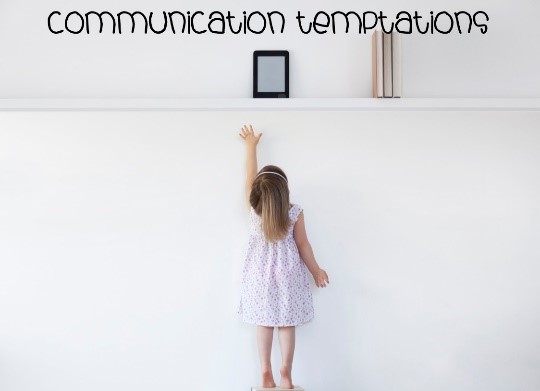 | 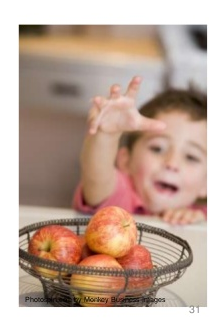 | 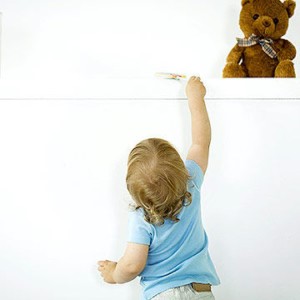 |  |
Here are a range of strategies that SLTs often use to encourage students to communicate. They work really well to support students to use their communication systems. All communication partners can use these strategies to help facilitate and extend communication when playing or doing activities together.
Note: underlined words are being pointed to on the communication system as well as spoken aloud in the following examples.
Once a child is motivated by an activity or toy, there are several little tricks the adult or communication partner can have up their sleeve to maximize the communication exchanges that occur while the child engages with that activity or toy.
Playing with bubbles is a great example. If a child requests bubbles and you hand the bubbles over to them, you have supported one communication exchange.If when they ask for bubbles you pretend to struggle with the lid, ask for help, offer help, act like you don’t know what to do now, blow bubbles, wait expectantly... then you have supported multiple communication opportunities.

Here are some similar strategies to try...
- Have a favourite toy in view but out of reach. If the child points to looks at their toy, you could use their communication system to model “oh, I think you are telling me ‘I want it’”. Then wait expectantly and see if they will use their system to communication I want.
- Do something unexpected… how can you switch up a routine in a fun or silly way? E.g. when getting dressed try putting a shoe on your head or at bed time try putting your pillow under your bed and pretending to go to sleep under the bed. If at school put your sunhat on your knee and say you are ready to go to the playground then look at your student. Wait and see what reaction you get. Perhaps get someone else to model comments like not like that, you silly, you need help, that funny, etc. Leave things open ended... what are your child or student’s favourite things to talk about and play? What words and phrases can you use when engaging in these activities with your
- Give little bits of a favourite item or give it over piece by piece with lots of waiting expectantly for the child to ask for more... this works well with food items, interactive songs and rhymes, Lego pieces and puzzles, playdough, etc.
- Novelty... have some really exciting new toys in a special box or bag that you magically bring out to look at one at a time then put away in the box for another session to keep them super enticing. Wait expectantly and see what your student says about these cool items!
- Sabotage…deliberately setting up situations that require the child to use language to communicate, e.g. give your child dinner but no utensils, give them a family toy with missing pieces, set up the train tracks but don’t give any trains, take the batteries out of a favourite toy, try reading a book upside-down, give your child an empty playdough container. Keep in mind that a little frustration helps motivate communication but failure does not, so observe how frustrated your child is and don’t push them too far – we want them to learn to strive not learn to fail.
- Act ‘dumb’… Start doing a familiar routine and then act ‘dumb’ as if you don’t know what to do next. See if the child will help you or tell you what to do next, e.g. put the child in the bath tub but don’t run any water. You could model “Oh silly me, I forgot the water. Oops! I will turn on the tap now.”
- Do something unexpected… how can you switch up a routine in a fun or silly way? E.g. when getting dressed try putting a shoe on your head or at bed time try putting your pillow under your bed and pretending to go to sleep under the bed. If at school put your sunhat on your knee and say you are ready to go to the playground then look at your student. Wait and see what reaction you get. Perhaps get someone else to model comments like not like that, you silly, you need help, that funny, etc.
- Leave things open ended... what are your child or student’s favourite things to talk about and play? What words and phrases can you use when engaging in these activities with your child/student?
Adult Super Powers
Here are some things you, the adult, can do to be a great communication partner...
- Attribute meaning
Even if your child /student is using their system to say what appears to be random or unrelated words... attribute meaning to them so they are encouraged to keep trying. If you are eating snack and they randomly say make you could say....”Yes, your dad made your lunch for you...its yummy hey!”

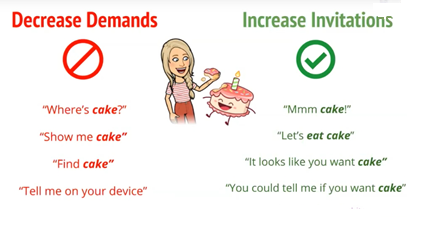 | Graphic from https://www.rachelmadel.com/ |
- Decrease demands / increase invitations
In the past, we have expected students to ‘show’ us that they know where words are located on their communication systems and what those words mean. We made lots of demands on them, which is like continually testing them. Instead we should be teaching them through increasing the number of invitations we give them to communicate about motivating topics! Look how different the morning tea interaction example above is depending on whether the adult demands the child to ‘show’ what they know, verses inviting them to communicate because communication looks and sounds like so much fun! It is such a subtle shift in our language from telling children what to say, to inviting them to communicate.
- Model a wide range of language functions not just requesting
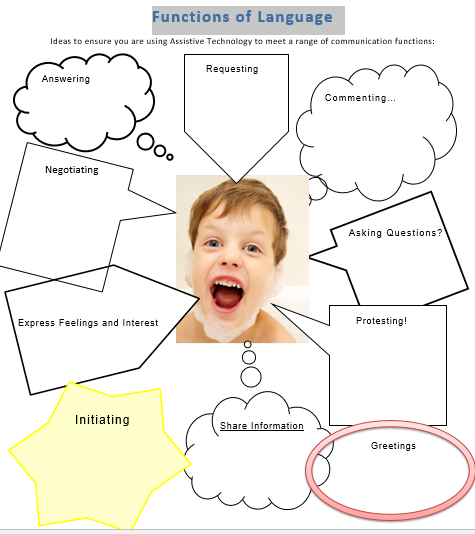
We use language for so many purposes beyond simply talking about what we want. We can create opportunities to give children the option to comment/protest/ask and answer questions/tell stories/describe things/tell a joke/greet people/ talk about feelings.
References: Rachel Madel, Caroline Musselwhite, Linda Burkhart
Created by Polly Thomas and Jessamy Bell (TalkLink Teacher Trainer and SLT) May 2020
To download this tip of the month as a PDF, please click here
 |  |  |  |
Here are a range of strategies that SLTs often use to encourage students to communicate. They work really well to support students to use their communication systems. All communication partners can use these strategies to help facilitate and extend communication when playing or doing activities together.
Note: underlined words are being pointed to on the communication system as well as spoken aloud in the following examples.
Once a child is motivated by an activity or toy, there are several little tricks the adult or communication partner can have up their sleeve to maximize the communication exchanges that occur while the child engages with that activity or toy.
Playing with bubbles is a great example. If a child requests bubbles and you hand the bubbles over to them, you have supported one communication exchange.If when they ask for bubbles you pretend to struggle with the lid, ask for help, offer help, act like you don’t know what to do now, blow bubbles, wait expectantly... then you have supported multiple communication opportunities.

Here are some similar strategies to try...
- Have a favourite toy in view but out of reach. If the child points to looks at their toy, you could use their communication system to model “oh, I think you are telling me ‘I want it’”. Then wait expectantly and see if they will use their system to communication I want.
- Do something unexpected… how can you switch up a routine in a fun or silly way? E.g. when getting dressed try putting a shoe on your head or at bed time try putting your pillow under your bed and pretending to go to sleep under the bed. If at school put your sunhat on your knee and say you are ready to go to the playground then look at your student. Wait and see what reaction you get. Perhaps get someone else to model comments like not like that, you silly, you need help, that funny, etc. Leave things open ended... what are your child or student’s favourite things to talk about and play? What words and phrases can you use when engaging in these activities with your
- Give little bits of a favourite item or give it over piece by piece with lots of waiting expectantly for the child to ask for more... this works well with food items, interactive songs and rhymes, Lego pieces and puzzles, playdough, etc.
- Novelty... have some really exciting new toys in a special box or bag that you magically bring out to look at one at a time then put away in the box for another session to keep them super enticing. Wait expectantly and see what your student says about these cool items!
- Sabotage…deliberately setting up situations that require the child to use language to communicate, e.g. give your child dinner but no utensils, give them a family toy with missing pieces, set up the train tracks but don’t give any trains, take the batteries out of a favourite toy, try reading a book upside-down, give your child an empty playdough container. Keep in mind that a little frustration helps motivate communication but failure does not, so observe how frustrated your child is and don’t push them too far – we want them to learn to strive not learn to fail.
- Act ‘dumb’… Start doing a familiar routine and then act ‘dumb’ as if you don’t know what to do next. See if the child will help you or tell you what to do next, e.g. put the child in the bath tub but don’t run any water. You could model “Oh silly me, I forgot the water. Oops! I will turn on the tap now.”
- Do something unexpected… how can you switch up a routine in a fun or silly way? E.g. when getting dressed try putting a shoe on your head or at bed time try putting your pillow under your bed and pretending to go to sleep under the bed. If at school put your sunhat on your knee and say you are ready to go to the playground then look at your student. Wait and see what reaction you get. Perhaps get someone else to model comments like not like that, you silly, you need help, that funny, etc.
- Leave things open ended... what are your child or student’s favourite things to talk about and play? What words and phrases can you use when engaging in these activities with your child/student?
Adult Super Powers
Here are some things you, the adult, can do to be a great communication partner...
- Attribute meaning
Even if your child /student is using their system to say what appears to be random or unrelated words... attribute meaning to them so they are encouraged to keep trying. If you are eating snack and they randomly say make you could say....”Yes, your dad made your lunch for you...its yummy hey!”

 | Graphic from https://www.rachelmadel.com/ |
- Decrease demands / increase invitations
In the past, we have expected students to ‘show’ us that they know where words are located on their communication systems and what those words mean. We made lots of demands on them, which is like continually testing them. Instead we should be teaching them through increasing the number of invitations we give them to communicate about motivating topics! Look how different the morning tea interaction example above is depending on whether the adult demands the child to ‘show’ what they know, verses inviting them to communicate because communication looks and sounds like so much fun! It is such a subtle shift in our language from telling children what to say, to inviting them to communicate.
- Model a wide range of language functions not just requesting

We use language for so many purposes beyond simply talking about what we want. We can create opportunities to give children the option to comment/protest/ask and answer questions/tell stories/describe things/tell a joke/greet people/ talk about feelings.
References: Rachel Madel, Caroline Musselwhite, Linda Burkhart
Created by Polly Thomas and Jessamy Bell (TalkLink Teacher Trainer and SLT) May 2020
To download this tip of the month as a PDF, please click here
